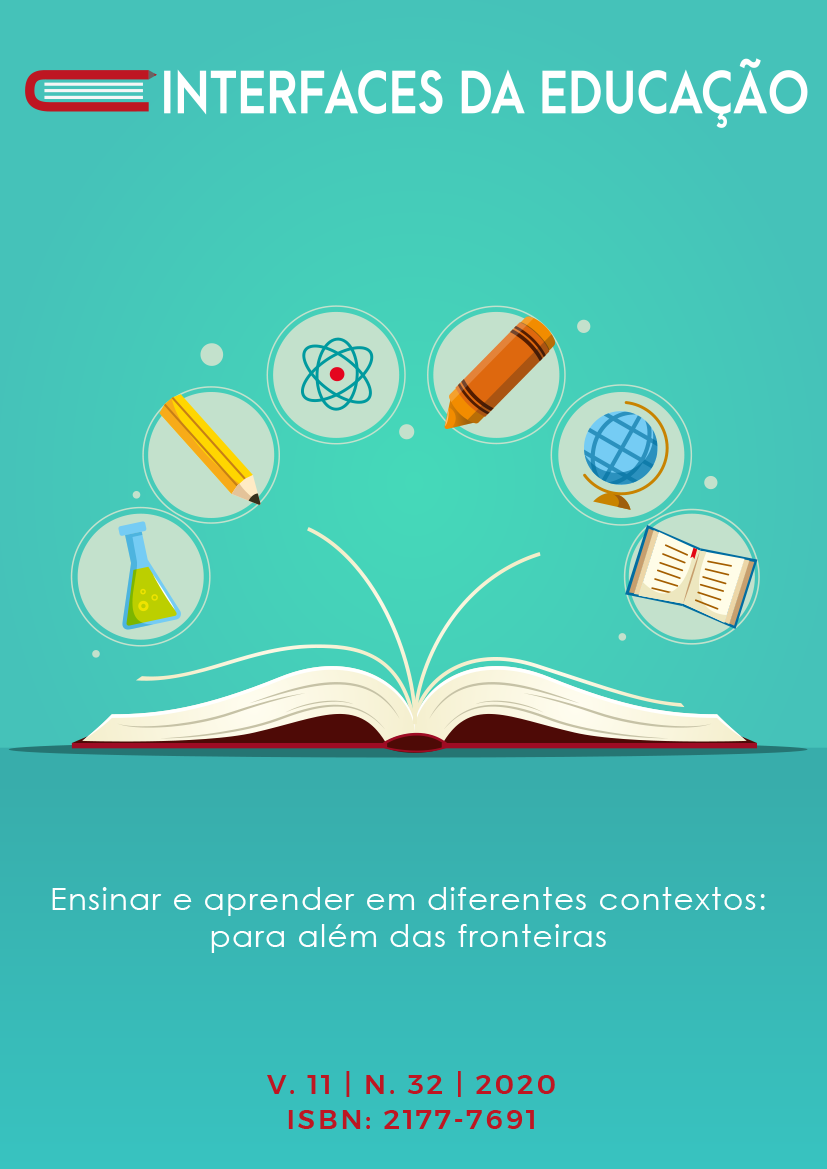Critical Thinking and Creative Pedagogies in the Classroom
DOI:
https://doi.org/10.26514/inter.v11i32.4968Palavras-chave:
Critical thinking. Active pedagogies. Inquiry-based learning. Project-based learning. Problem-posing method.Resumo
The article discusses the meanings and the roles of critical thinking in the classroom. We start by placing the concept within the progressive pedagogical movement, which is rooted in the idea of learning by doing. Experiential learning is at the core of this kind of pedagogy and the belief is that students can only truly learn by engaging with the curriculum in an active and meaningful manner. Developing critical thinking is the goal of any educational system, particularly in democratic nations that understand schooling as a way of socializing children into the life of society as productive citizens. Although there seems to be an agreement in the importance of critical thinking in schools, teachers still find it difficult to develop practical classroom lessons and instructional strategies that develop higher order thinking skills. We discuss inquiry and project-based learning as well as Freire’s problem-posing approach as pedagogical instructional tools that can be used in the classroom to help students develop critical thinking. What do you want to do ?New mailCopyReferências
AUERBACH, ELSA. Making meaning, making change: A guide to participatory curriculum
development for adult ESL and family literacy. Boston: University of Massachusetts, 1990.
BALCAEN, PHILIP L. The Pedagogy of Critical Thinking: Object Design Implications for Improving Students’ Thoughtful Engagement Within E-learning Environment. US-China Education Review, B3, p. 354-363, 2011.
BATTERSBY, MARK. Critical Thinking as Applied Epistemology: Relocating Critical Thinking in the Philosophical Landscape. Informal Logic, XI, 2, p. 91-100, 1989. From: file:///C:/Users/bsantos/Downloads/2623-Article%20Text-4662-1-10-20090812.pdf. Retrieved October 12, 2019.
BERAN, MICHAEL KNOX. In Defense of Memorization, 2004. From: https://www.city-journal.org/html/defense-memorization-12803.html. Retrieved October 10, 2019.
BOSS; SUZIE; LARMER; JOHN. Project Based Teaching: How to Create Rigorous and Engaging Learning Experiences. Alexandria, VA: ASCD, 2018.
COLLINS, ALLAN and HALVERSON, RICHARD. Rethinking Education in the Age of Technology: The Digital Revolution and Schooling in America. New York: Teachers College Press, 2018.
DEWEY, JOHN. How We Think. Boston: D.C. Heath, 1910. DOI: https://doi.org/10.1037/10903-000
______. How We Think: A Restatement of the Relation of Reflective Thinking to the Educative Process. Lexington, MA: D.C. Heath, 1933.
______. Experience and Education. New York: Kapa Delta Pi, 1938.
FREIRE, PAULO. Pedagogy of the oppressed. New York, NY: Continuum International Publishing Group, 1970.
GLADWELL, MALCOLM. Talking to Strangers: What We Should Know About the People We Don’t Know. New York, NY: Little, Brown and Company, 2019.
HARE, REBECCA LOUISE; DILLON, ROBERT. The Space: A Guide for Educators. Irvine, CA: EdTechTeam Press, 2016.
HIRSCH. E. D. Jr. Why Knowledge Matters: Rescuing Our Children from Failed Educational Theories. Cambridge, MA: Harvard Education Press, 2016.
INSIGHT ASSESSMENT. Characteristics of Strong Critical Thinkers. From: https://www.insightassessment.com/article/characteristics-of-strong-critical-thinkers. Retrieved April 23, 2020.
JONATHAN BARON. Thinking and deciding (2nd edition). New York: Cambridge University Press, 1994.
______. Actively open-minded thinking. Almanac, Volume 42, Number 24, 1996.
KIDDER, Jon. Testimony on Progressive Education. From: https://progressiveeducationnetwork.org/. Retrieved April 21, 2020.
LITTLE, TOM; ELLISON, KATHERINE. How Progressive Education Can Save America's Schools. New York: W. W. Norton & Company, 2015.
MACKENZIE, TREVOR. Dive into Inquiry: Amplify Learning and Empower Student Voice. Victoria, BC: Elevate Books Edu, 2019.
MICHAEL W. APPLE. Official Knowledge (3rd edition). New York: Routledge, 2014. DOI: https://doi.org/10.4324/9780203814383
NAIDITCH, FERNANDO. (Ed.). Developing critical thinking: From theory to classroom practice. Lanham, MD: Rowman & Littlefield, 2017.
______. A media literate approach to diversity education. Journal of Media Literacy Education, 5(1), 337–348. 2013.
______. Critical pedagogy and the teaching of reading for social action. Critical Questions in Education, 1(2), 94-107, 2010.
NICHOLAS, MARK C.; RAIDER-ROTH, MIRIAM. A Hopeful Pedagogy to Critical Thinking. International Journal for the Scholarship of Teaching and Learning, 10 (2), p. 1–10, 2016. DOI: https://doi.org/10.20429/ijsotl.2016.100203
PAGE, SCOTT E. The Difference: How the Power of Diversity Creates Better Groups, Firms, Schools, and Societies. Princeton, NJ: Princeton University Press. 2007 DOI: https://doi.org/10.1515/9781400830282
PEDASTE, MARGUS et. al. Phases of inquiry-based learning: Definitions and the inquiry cycle. Educational Research Review, vol. 14, pp. 47-61, 2015. From https://doi.org/10.1016/j.edurev.2015.02.003. Retrieved October 10, 2019. DOI: https://doi.org/10.1016/j.edurev.2015.02.003
PETER A. FACIONE. Critical Thinking: A Statement of Expert Consensus for Purposes of Educational Assessment and Instruction – The Delphi Report. Insight Assessment. California Academic Press, 1998.
ROBERT H. ENNIS. Critical Thinking. Upper Saddle River, NJ: Prentice Hall, 1995.
SANTOS, B. S.; SPAGNOLO, C.; BUCKER, C. Creativity and Motivation in the Teaching and Learning Process. In: Fernando Naiditch. (Org.). Developing Critical Thinking: From Theory to Classroom Practice. 1ed.Lanham, Maryland: Rowman & Littlefield, 2016, v. 1, p. 1-175.
SHOR, IRA. Empowering Education: Critical Teaching for Social Change. Chicago: University of Chicago Press, 1992. DOI: https://doi.org/10.7208/chicago/9780226147864.001.0001
STACEY, SUSAN. Inquiry-Based Early Learning Environments: Creating, Supporting, and Collaborating. St. Paul, MN: Redleaf Press. 2018.
WILHELM; P.; BEISHUIZEN; J. J. Content effects in self-directed inductive learning. Learning and Instruction, vol. 13, p. 381-402, 2003. DOI: https://doi.org/10.1016/S0959-4752(02)00013-0
WILLINGHAM, DANIEL T. Critical thinking: Why is it so hard to teach? American Educator, summer issue, 8–19, 2007.
Downloads
Publicado
Como Citar
Edição
Seção
Licença
Autores que publicam nesta revista concordam com os seguintes termos:
a. autores mantém os direitos autorais e concedem à revista o direito de primeira publicação, com o trabalho licenciado simultaneamente sob uma Licença Creative Commons Attribution após a publicação, permitindo o compartilhamento do trabalho com reconhecimento da autoria do trabalho e publicação inicial nesta revista;
b. autores têm autorização para assumir contratos adicionais separadamente, para distribuição não-exclusiva da versão do trabalho publicada nesta revista (ex.: publicar em repositório institucional ou como capítulo de livro), com reconhecimento de autoria e publicação inicial nesta revista;
c. autores têm permissão e são estimulados a publicar e distribuir seu trabalho online (ex.: em repositórios institucionais ou na sua página pessoal) a qualquer ponto antes ou durante o processo editorial, já que isso pode gerar alterações produtivas, bem como aumentar o impacto e a citação do trabalho publicado.


